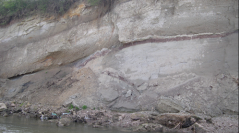

 Comptes Rendus Palevol
21 (13) - Pages 253-271
Comptes Rendus Palevol
21 (13) - Pages 253-271Surprisingly, after the Early Cretaceous taxonomic diversity recorded in Europe, which probably is largely an artifact of inadequate taxonomy and inflation of taxa, multituberculate mammals became extremely scarce in the Late Cretaceous in this continent, being reported exclusively from the uppermost Cretaceous continental deposits of the so-called “Hațeg Island” in Transylvania, Romania. Such mammals have been documented from the Hațeg and Rusca Montană sedimentary basins, as well as from the southwestern area of the Transylvanian Basin. All these records belong to the endemic family Kogaionidae. The present paper reports additional data related to the smallest Cretaceous kogaionid, Barbatodon oardaensis Codrea, Solomon, Venczel & Smith, 2014 based on a series of new isolated teeth recovered mainly from the type locality, Oarda de Jos (Oarda A). Furthermore, the fossil localities Oarda B and Vălioara are other new occurrences for the species. Based on this new material, the intraspecific variability of B. oardaensis is confirmed and its presence is attested in the three basins. Details related to the diversity of the “Hațeg Island” kogaionids are also provided.
Kogaionidae, multituberculates, Late Cretaceous, “Hațeg Island”, diversity